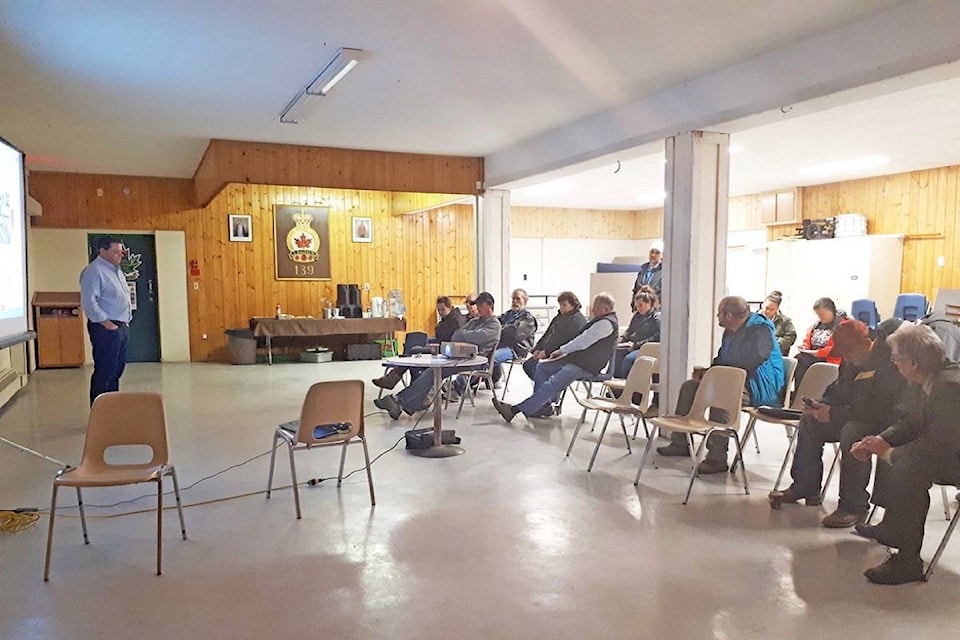Mount Polley Mine has removed 350,000 tonnes of tailings in a 13.9-hectare area and restored 1.25 kilometers of fish habitat as part of its ongoing remediation of areas impacted by the 2014 tailings impoundment breach, environmental supervisor Colleen Hughes said.
Hughes was speaking at a community meeting hosted by the mine at the legion in Williams Lake on Nov. 16 that attracted 16 people.
“We have also installed 6.4 kilometres of the pipeline [to Quesnel Lake] and Hazeltine Creek is no longer reporting to the diffusers in Quesnel Lake.”
Lee Nikl, senior environmental scientist with Golder Associates, outlined remediation monitoring that has been completed so far and considerations Imperial Metals is taking as the work continues.
A human health risk assessment completed and submitted by Golder has been accepted by the Ministry of Environment and an ecological risk assessment is being finalized, Nikl said.
“We were asked immediately after the breach what is being done to stop ongoing releases from the breach area, how much was released and what are the effects of the release on health and on the environment and what is Mount Polley doing to fix the environmental effects?”
As a result, the mine identified nine remediation areas that included the plug at Polley Lake, Polley Lake, the tailings storage facility, upper Hazeltine Creek, Hazeltine Canyon, Lower Hazeltine Creek, Edney Creek Mouth and Quesnel Lake, Nikl noted.
“For each of those areas we’ve come up with a table to see what are the problems, what do we know is wrong, what is it that we already know that will inform the decisions that we make, and what do we need to know to do in the short-term and what do we think we will do in the long-term.
“There is always uncertainty in any sort of scientific endeavour, so we needed to determine what sort of contingency there might be to deal with that uncertainty and what kind of monitoring would be done.”
Quesnel Lake resident Doug Watt said he knows the pristine quality of the lake prior to the breach has not been restored.
“In the last three weeks, we’ve seen more of that green slime and greenish water coming down the lake, which would be indicative of a recent release of suspended solids.”
Responding chief scientific officer Lyn Anglin said a research group from the University of Northern British Columbia has sent lake sediment core samples to a lab in the United Kingdom for further research.
“They will be looking at what the sheer force needs to be to re-suspend sediments off the bottom of Quesnel Lake. All of the creeks that run into the lake do contribute sediment, so there are a lot of sources.”
Anglin said it is difficult to make comparisons because the data prior to the breach is very limited, but if there are things people think the monitoring programs are missing, Mount Polley is open to suggestions.
Watt said people on the lake know the slime, which they call “rock snot,” was not there before.
“The turbidity is there and there is copper in the bottom of the lake that is coming up.”
He also criticized the company for adhering to water quality standards that are “totally artificial to Quesnel Lake.”
“You are not looking to return the lake to what it was before and you are using the lake as a depository for the effluent,” Watt said. “That still bothers us.”
Nikl replied that water quality guidelines are only one of the measures used for monitoring.
“We look at many other measures such as invertebrate, toxicity testing in solid phase and water phase,” he said, noting ongoing geochemistry studies are looking at whether the copper is being released from the bottom of the lake.
Hughes encouraged people at the meeting to read the technical and monitoring reports that are available on the Imperial Metals website.
